This article is about the importance of image selection. Image Selection refers to the images you (as a photographer) choose to capture (with your camera), edit and display. I feel it is an important issue, and this is an article that I've been wanting to write for a long time - almost as long as I've been working on this blog (since December 2006, if anybody's keep track).
I've defined what I consider image selection to be. But to be clear, I should define one more word. This blog (and digital photography itself) deals largely with editing images. For the rest of this post, I will refer to editing as the manipulation of images (either in camera, with software like Picasa [great, free program] or Photoshop, or whatever method you use).
Image selection seemed to me to be an innocuous topic when I began discussing it with others, but it has caused some heated debates as well as many excellent discussions.
The idea of image selection was first brought to my attention a couple of years ago by my good friend (and current MFA student at NSCAD in Halifax, NS) when I sent him an email with a half dozen images I had just shot and edited. There were really only two distinct images there, but several slightly different angles of the same two shots. I was not asking him for his opinion on which image was better and why - I was showing him those images to showcase my recent work.
It was then that my friend, whom I had just shown several nearly identical variations of two images, enlightened me. He told me that image selection is a critical part of photography, and is a large part of what defines us individually as photographers.
Educated Support
It's important to point out that this notion of image selection being important is not just an idea that my friend and I support. I had a quick flick through my photo literature and came up with these sources supporting this same principle.
First, from my favourite photographic author, Freeman Patterson (mental note: dedicate entire posts about him in the future). One of his many excellent books is Photography and the Art of Seeing: A Visual Perception Workshop for Film and Digital Photography (3rd edition, 2004, Key Porter Books Ltd.).
This entire book talks about design and visual expression, but in the summation, the author states: "You must... become sensitive to the essence of the subject matter.... Then you decide which themes are expressed through the situation or event..., and select the details that best express the theme you choose to illustrate." (p. 145).
Understanding your subject and how you want to express that understanding is essential to image selection. It is best, though not critical, to think about what you're shooting and why even before you put the camera to your eye. What is the subject; what guides your eye to the subject (and what leads your eye away); what is unique about the photo you will capture; what technical considerations must you make (DOF, focal length, detail, exposure...)? Are you capturing an image for the sake of capturing, or are you making the best photograph you (or anybody) can make? If you're taking the time to truly learn photography (and I hope that in reading this, you are), then I'm guessing you want to make the best image of whatever it is that you are photographing that you can.
Another great book (that I wish the author would re-issue) is Photojournalism: Content & Technique (Greg Lewis, 2nd edition, Wm. C. Brown Communications Inc., 1995).

In a section on photo editing and selecting photos for publication, the author states "photo editing is the entire process of selecting photos from the photographer's take, cropping them, determining, or at least influencing, their use on the printed page.... Photo editing begins when you press the [shutter]. You should be thinking about the needs of the story and the photos you can make that will tell the story best" (p. 210).
While the author is speaking specifically about printed photojournalism (the book was published in 1995), the theory is just as relevant today, whether your pictures end up in newspapers, magazines, websites, or sold or hung around your home.
The author goes on to state that "it is not unusual for a photographer to become subjectively involved with the photos and think an image says more than it really does" (p. 210). It is important to step back from your photos and try to take a more objective look at them. If you have several images you are trying to choose between, it is appropriate to share them with others to get feedback and perspective on them. I know this contradicts much of what I've said so far, but this sort of image sharing should be done with a more selective audience and is important to do occasionally to gain a fresh perspective on your own work.
Judging Your Photos
Judging your own photographs can be a difficult task. I get reminded of this any time I decide to enter a single image into a photo competition, choose an image to print for a friend, or pick just a half dozen images to put up on this blog to show the "best" of my work from the past several months. Leading up to these events, I often feel proud (or disgusted!) with many of my images, but when I have to choose a limited selection of images that represent my work, I find myself looking at my work much differently. It is often a good way to rethink my work, decide what I need to work on, and realize what, if any, progress I've made.
A good (though a little dry) book is Criticizing Photographs: An Introduction to Understanding Images (Terry Barrett, 3rd edition, McGraw-Hill Higher Education, 2000). This book deals largely with fine art photography and very in-depth photographic critiquing.
In the section of this book called Evaluating Photographs, the author says "a judgement is a what that demands a why. Judgements, like interpretations, depend on reasons. Judgements without reasons are not particularly beneficial. To declare something 'good' or 'bad', 'original' or 'remarkable,' without giving reasons as to why it is thought to be so is merely to offer a conclusion, and however well founded or thought out that conclusion might be, it is not very revealing or helpful if the reasons behind it are not offered in its support" (p. 117).
The author goes on to say that "like interpretations, judgements are neither definitively nor absolutely right or wrong. Rather, judgements, like interpretations, are more or less convincing, persuasive, and compelling, depending on how well or poorly they are argued" (p. 119).
From this statement comes a great point for practice - learn to justify your favourite pictures. Imagine explaining the merits of your photos (either individually, or a set of images you feel would represent your portfolio) to viewers. How would you tell someone who doesn't study photography why you didn't place the subject in the very centre of the image (or explaining to someone who recently learned the rule of thirds why you did put the subject dead centre!); if you were in a fine art photography class, how would describe your photo (try to come up with a full two minutes of intelligent discussion); if you were selling your work (or yourself - err, photographically speaking), how would you describe your knowledge/technique/vision?
Discussion forums on sites such as DPReview can be good or bad. If you ask specifically for some constructive criticism, it will often come to you (note: don't get your back up. Learn to intelligently defend yourself and/or learn from what people are sharing with you), but hold on to your ego. It is not uncommon for an undeserving (in my humble opinion) image to get dozens of gushing reviews. Listen to the negatives, store them away somewhere, and if you don't agree, teach others what you know, too. (Again, be calm and intelligent. Please - make photography a civilized community with sharing and compassion.)
Not every image has to be technically perfect, of a gorgeous model, or from some far-off corner of the earth. It's OK to have as a favourite image a picture of a grandmother holding her first grandchild even if it is underexposed, crooked and out of focus. Capturing the moment is often what photography is about. But from an image like that, we must learn for the next opportunity. What lens should we have had ready; what ISO would have made the light/sharpness/DOF more appropriate; what lighting would have made the image stronger; what angle could have helped; what coaching could have been done to improve the composition?
We have talked about a lot here, and I do hope it has been helpful to you. When I started thinking about my own photography more critically, it changed what I shot, how I shot, and what I shared. I started thinking about every image I shared as a reflection of what I saw, how I saw it, and how I was able to capture it. No more did I want dozens of images that all looked the same. I do have favourite themes, and do work similar subjects often, but I try harder now to see different angles, different subjects, and always practice different techniques to diversify and perfect my style.
If you have any questions, opinions or related stories, I would love to hear them. I leave you with a small selection of my favourite images from the past few months and another great piece from Freeman Patterson's Photography and the Art of Seeing: "An appreciation of natural design and a knowledge of the principles of visual design will play a major part in your selection of subject matter and the success and impact of the final image" (p. 145).
Thanks,
Matt
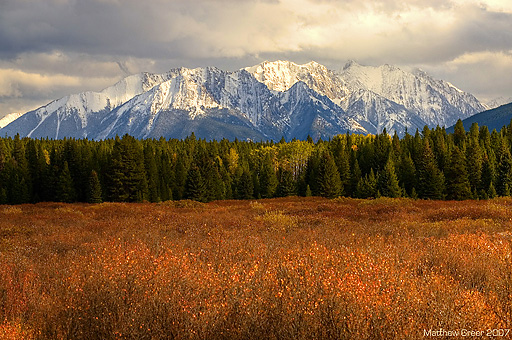
Shot with Nikon D70s and 70-300VR, near Johnston Canyon, Alberta. The repeating patterns in the fore/mid/background make me really love this shot. The warm reds and cool blues/whites play well off of each other, and there is great detail throughout.
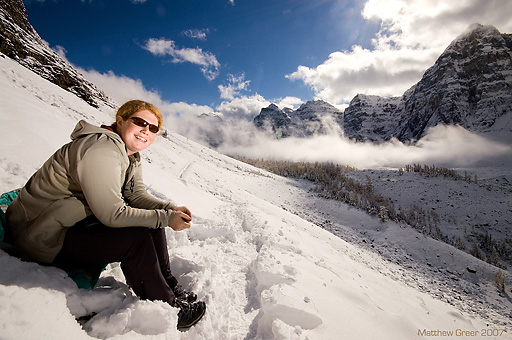
My wife, Amy, shot with Nikon D70s, Sigma 10-20mm, and SB-600 triggered wirelessly (camera right). The lighting balance, feeling of expanse, and completion of story told (the trail should be a clue...) make this one of my favourites.

Shot with Nikon D70s and Sigma 10-20mm. The leaf is real, and the house is reflected in the roof of my car. I went out that day looking for expansive, generic fall shots and birds. I was thrilled when I saw this (natural!) composition - the yellows, blues, and strange image of a house upside down.
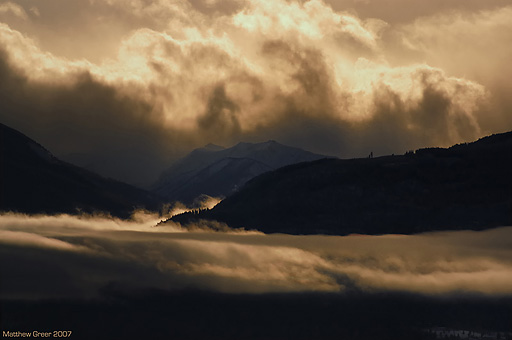
Shot with Nikon D70s and 70-300VR. This is a case of not seeing the possibilities as I shot. The original was 2 full stops lighter (hooray for RAW!), but by darkening the image, it strengthened the mood and brought out more of the texture in the image.
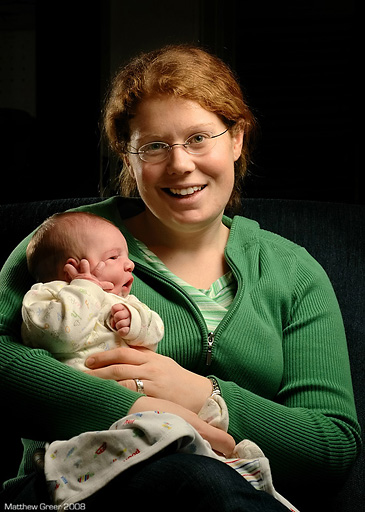
Shot with Nikon D70s and 60mm Micro. I've been working on my lighting (thank you Strobist) for close to a year now. This captured the excitement my wife had at seeing her new niece, and did so well (if I do say so myself). Flash through umbrella camera right, bare flash camera left, behind subjects, creating rim light.
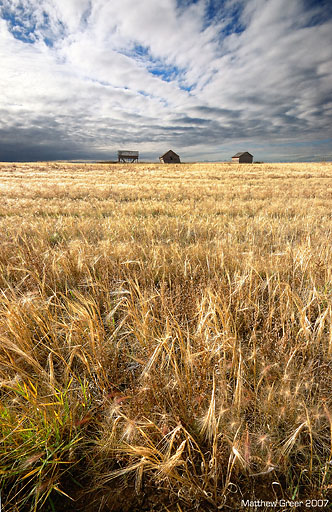
Shot with Nikon D70s and Sigma 10-20mm. It didn't take me long to justify getting this lens - the huge expanse, the great detail, and the wonderful feeling (middle of a wheat field, miles from anything) this image has make me smile every time I see it.

Shot with Nikon D70s and 70-300VR, near Johnston Canyon, Alberta. The repeating patterns in the fore/mid/background make me really love this shot. The warm reds and cool blues/whites play well off of each other, and there is great detail throughout.

My wife, Amy, shot with Nikon D70s, Sigma 10-20mm, and SB-600 triggered wirelessly (camera right). The lighting balance, feeling of expanse, and completion of story told (the trail should be a clue...) make this one of my favourites.

Shot with Nikon D70s and Sigma 10-20mm. The leaf is real, and the house is reflected in the roof of my car. I went out that day looking for expansive, generic fall shots and birds. I was thrilled when I saw this (natural!) composition - the yellows, blues, and strange image of a house upside down.

Shot with Nikon D70s and 70-300VR. This is a case of not seeing the possibilities as I shot. The original was 2 full stops lighter (hooray for RAW!), but by darkening the image, it strengthened the mood and brought out more of the texture in the image.

Shot with Nikon D70s and 60mm Micro. I've been working on my lighting (thank you Strobist) for close to a year now. This captured the excitement my wife had at seeing her new niece, and did so well (if I do say so myself). Flash through umbrella camera right, bare flash camera left, behind subjects, creating rim light.

Shot with Nikon D70s and Sigma 10-20mm. It didn't take me long to justify getting this lens - the huge expanse, the great detail, and the wonderful feeling (middle of a wheat field, miles from anything) this image has make me smile every time I see it.
6 comments:
Good article, very true. I used to do the same thing with keeping way too many shots of the same subject until it occurred to me that movies, music, books, etc... don't have similar scenes/lines one after another because the artist couldn't- or was afraid- to choose.
But it is up to us to learn what's good and make that choice, else we bore our viewers with needless repetition.
Great! I'm watching your works and posts. Congratulations..
Ozgur Tekinsen.
great post ..i enjoyed reading it.
hey my name is matt greer too! and im a photographer! small world
Wonderful work!!!
Incredible work man!
Post a Comment